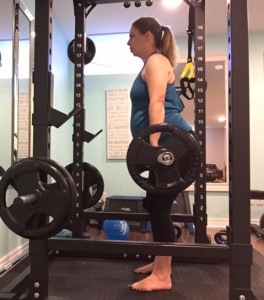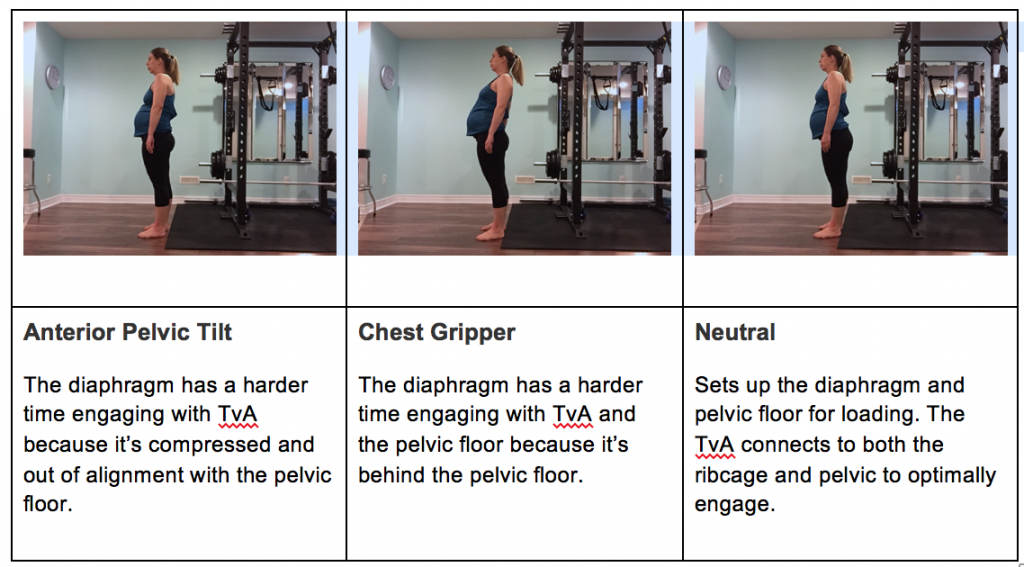Why “All or Nothing” Is a Bad Idea For Pregnant Athletes
Today I have a guest post by a Canadian personal trainer, Terrell Baldock. You may wonder why I spend so much time talking about pelvic floor health and stuff that may not make the Instagram role, and especially since I’m a large dude who likes to lift heavy stuff. Well, 51% of the population is female. About 71% of the readers on this site are female, more and 60% of fitness spending is by females, the main age group reading this site are 25-44 year olds (right in that fun post-pregnancy range), and far too often females are targeted with fear-based marketing that teaches them to be vulnerable or to ignore their bodies and push through pain. So in that discussion, this post helps show that you can lift weights after pregnancy, not only because it’s important, but because it’s something all trainers should talk about since it deals directly with the largest segment of our clientele.
Most athletes — and almost all trainers — are familiar with the “all or nothing” fallacy in training and nutrition. It’s the mistaken idea that if you can’t do things to the max, you shouldn’t do them at all.
Yet during and after pregnancy many athletic women and their coaches fall prey to two equally bad ideas at opposite ends of spectrum.

Either you should do almost no exercise for the months during and after pregnancy, or you should pretty much ignore your pregnancy and carry on as before. After all, you’re an athlete! A little adversity only makes you stronger. What’s a little pissing on the gym floor in the grand scheme of the universe?
I disagree. Here’s why.
Too little exercise and too much exercise during and after pregnancy are both bad ideas. The truth and best practices lie somewhere in between.
But where exactly do you draw the line? I’ll do my best to come up with some thoughtful answers to that question in this post, drawing on the latest research and my own experience as an athlete, strength coach, mom, and certified Personal Trainer.
Amanda’s Story And Why It Matters
Meet Amanda, an avid CrossFitter who has been training regularly for over two years. She continued to train throughout her entire pregnancy, which was normal and uncomplicated.
Six weeks postpartum, Amanda’s doctor cleared her to resume exercise. That’s pretty standard circumstances. Amanda resumed her CrossFit workouts, including competing in the CrossFit Open.
And that’s when the problems started.
Amanda noticed when she was doing her squats, her core felt like it was “caved in” and she felt unstable. She also noticed that when she was working at a high impact, mostly running, she felt like she had “marbles down there” and had a flow of urine that she never had before.
And there was more. Amanda had lower back pain when doing barbell back squats.
Amanda was not happy. She felt like she had to give up CrossFit because she was uncomfortable and her performance was lagging. It was taking an emotional toll.
Amanda saw a physiotherapist (they’re called physical therapists in the US) who specialized in pelvic floor issues. Amanda was diagnosed with a hypertonic pelvic floor, a grade one bladder prolapse, as well as diastasis recti just below her belly button.
Her physio recommended that Amanda discontinue strength training and opt for low impact exercise like cardio on an elliptical. This obviously didn’t sit well with Amanda.
What Happened Next
I started working with Amanda because she wanted to return to CrossFit at some point. It was an important part of her life and she liked how it made her feel.
My movement assessment instantly revealed dysfunctional movement patterns. Amanda had had a significant butt wink which is consistent with a hypertonic pelvic floor. She also had tight hip flexors, adductors, abductors and inactive glutes. During the diastasis check, Amanda she had to get up and pee as soon as I touched just below her belly button.
Which left the question:
If Amanda was fit and strong during her pregnancy, why was she having these problems postpartum?
Amanda’s had continued to train at her normal high level throughout pregnancy. She had been medically cleared to do so. She felt fine. She was listening to her body and her body wasn’t telling her to stop.
Here’s the answer:
What wasn’t considered was the structural and hormonal changes that were happening as Amanda’s pregnancy progressed. The core and pelvic floor changes were ignored.
During pregnancy, it’s common for the hip flexors to take over for spinal stability. Adductors, abductors, and glutes to become tight which can cause biomechanical changes in the gait pattern during pregnancy (https://www.ncbi.nlm.nih.gov/pubmed/?term=hip+flexors+stability+and+pregnancy), causing limitations for high impact training. When women continue to train, these muscle groups are impacted, They become tighter and less functional.
This makes it harder for the body to remain mobile and stable during pregnancy and birth. Sadly, mobility and stability is often not included in prenatal athletic training. This leaves women vulnerable to pelvic floor related injuries during birth and when they return to their training postpartum.
Training women during their pregnancies can minimize and prevent pelvic floor related injuries during birth which can affect their postpartum performance. Unfortunately, a strong majority of these women continue to train with pelvic floor dysfunctions because they’re dismissed as “normal” in their training communities and by their coaches.

But first, some definitions.
Pelvic Floor
The pelvic floor is like a woven basket that provides structural support, organ support, helps to maintain urinary and fecal continence, aids in sexual function and stabilizes connecting joints.
Diastasis Recti
Classified as the unnatural separation of the left and right rectus muscles 2cm or more. During pregnancy, the Linea Alba which is the connective tissue that runs down the midline of the abdomen, will begin to stretch away from the left and right rectus muscles.
Diastasis Recti is a natural part of the pregnancy process but when training during pregnancy, this can be exacerbated by heavy lifts, toes to bar, crunching and overhead lifts which are all common in high impact fitness programs like CrossFit. Additionally, with the hormone Relaxin making joints, ligaments and muscles lax in preparation for labour and birth–the pelvic floor and deep core system may be weaken making the pelvic floor vulnerable to injury.
What Should You Do? And When?
Women can continue high impact fitness programs during pregnancy, but it’s best to downtrain as pregnancy progresses.
Special emphasis should be placed on breathing. Diaphragmatic breathing encourages recruitment of the deep core (Diaphragm, pelvic floor, multifidus, and transversus abdominis TvA.) Avoiding the valsalva technique. Reduce the load and switch from barbells to kettlebells or dumbbells for some lifts when your belly begins to grow and alignment shifts.
As structural changes occur beginning in the second trimester, it’s common for the pelvis to tilt anteriorly, inhibiting mobility. This also places stress on the core system because the diaphragm and pelvic floor no longer in a stacked position.
When this happens, the TvA and multifidus are also unable to function optimally. This is where it’s common to experience low back/hip pain (Hodges et al 2003. ) This was another functional issue that Amanda was having following her lifting sessions.
It’s best to begin addressing alignment starting in the first trimester.
You will optimize alignment through these structural changes and reduce some common aches and pains that are typical in pregnancy and postpartum.

Train the deep core system and incorporate in all training and everyday life.
The pelvic floor is a dynamic muscle and it needs to move as the body moves. With the structural and hormonal changes along with high impact training during pregnancy, the pelvic floor can become hypertonic (tight), hypotonic (weak), or both and unable to meet the demands of both pregnancy and high level training.
Julie Wiebe PT is a Sports Medicine Physical Therapist based in California and who works with women, teaching them how to incorporate the Piston Breath into their training.
The Fit Floor Part Video 1
The Fit Floor Video 2
It’s important to include pelvic mobility into prenatal training. The pelvis tends to lose mobility and core stability due to the structural changes.
Women can can return to high level training postpartum without issue if they take the steps to prepare for the demands of pregnancy and birth, rehab following birth, then retrain and progressively overload when the timing is right.
What Happened With Amanda
I started working with Amanda during the rehab phase. We needed to address her alignment and mobility while working on deep tissue release before increasing intensity.
Had these steps been taken during Amanda’s pregnancy or when she returned to her training postpartum, the time required for the rehab phase would likely have reduced. Amanda likely would have been able to get back to high impact training with greater ease and fewer setbacks.
Strength training is also an important part of Amanda’s program. She’s a busy mom of three and needs to be able to meet her every day demands. She’s constantly lifting and carrying, so she needs to be strong and functional to manage her symptoms.
I started off looking at her overhead squat and assessed the movement pattern from her ankles all the way up to her head. She had a very distinctive butt wink and I could see her neck jetting out.
Amanda’s Overhead Squat
As you can see Amanda is unstable through her lower body as she gets to the bottom of her squat.
Front:
Side:
This told me that there was tightness surrounding her hips and was trying to use her neck to get through the squat. I had her lay on her back and ran my fingers down her IT Band–she was obviously uncomfortable. I then did the same with her adductors. There was some discomfort but not as much.
First, I had her roll out her IT Band and she did the overhead squat again. There was some improvement. Amanda repeated foam rolling her adductors. Again, improvement. Lastly, we used a therapy ball to release her piriformis and her overhead squat looked much better than the first.
Then I had Amanda start with rolling out her IT Band after assessing it for tightness. She found it uncomfortable as soon as I touched her. She did the Overhead Squat for a second time and there was some improvement.
Font:
Side:
I assessed her Adductors and they didn’t seem bothersome, then I had her do a piriformis release with a ball and repeated the squat. Again, there was some improvement from where she started.
Front and side:
The Takeaway
Amanda loves lifting so we have found ways for her to lift that keep her symptom free. She also enjoys running and I’ve incorporated some low impact High Intensity Interval Training and walking hill intervals on an elliptical trainer that she has at home. For her to remain interested and focused on her goals, she needs to be on a program that’s going to give that to her. At this point, Amanda hasn’t had any symptoms in her program
This is a very difficult process emotionally for Amanda. She enjoys the rush of her high impact training but understands the importance of down training and retraining to maximize her performance long term.
Amanda is still in the retraining process and it already seeing improvements. Her core is feeling stronger and she isn’t running to the bathroom during her sessions. I am gradually adding in some barbell training and increasing the level of impact as she progresses and gains more confidence. Amanda’s symptoms being managed as her pelvic floor and deep core system become balanced.
Amanda remains committed to the work and staying consistent. The future is bright.
And yours can be, too. Download my free guide Barbell Training For Pregnancy: Your 3 Step Guide For Maximizing Performance During and After Pregnancy.
About The Author

Terrell Baldock is a Prenatal and Postnatal Exercise Specialist in London, Ontario, Canada. She specializes in working with women with core and pelvic floor dysfunctions, and prepares them for the demands of pregnancy, birth and postpartum recovery. Check out her award-winning website Mom’s Fitness Boutique.